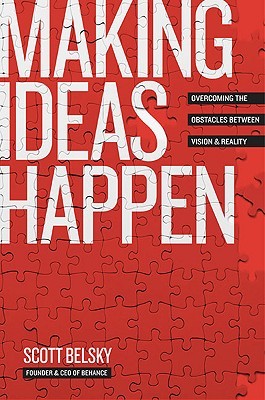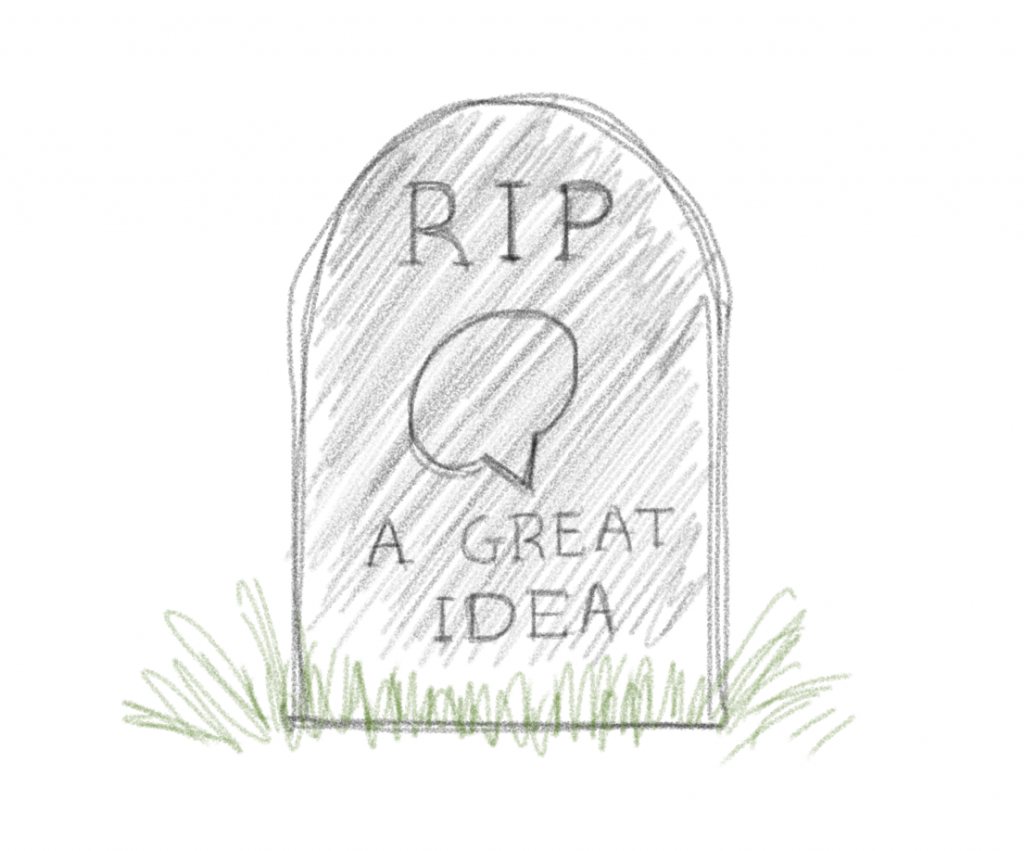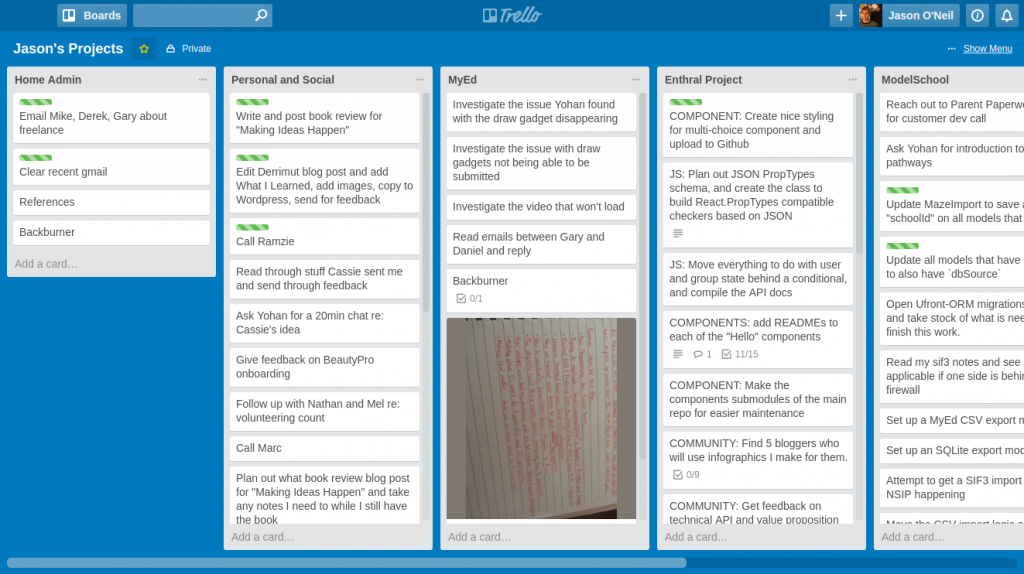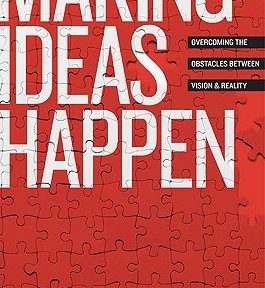On Sunday I finished reading “Making Ideas Happen” by Scott Belsky (founder of Behance).
 I’m the sort of person that has ideas. So many ideas. Some are ideas for apps or products, side projects or start-ups, cool programming libraries or fun creative projects. When I look back at my work history, I am proud of the things that I have “shipped” and finished, or if not finished, at least gotten it “finished enough” that other people could start using it.
I’m the sort of person that has ideas. So many ideas. Some are ideas for apps or products, side projects or start-ups, cool programming libraries or fun creative projects. When I look back at my work history, I am proud of the things that I have “shipped” and finished, or if not finished, at least gotten it “finished enough” that other people could start using it.
But there is definitely a graveyard of good ideas that I was very excited about at one point in time, that I even thought were game-changing, and maybe even started work on, but never managed to finish or get out there.
 As I was wrapping up 2016 and planning for 2017, I realised that I have several ideas that I actually want to see become reality. Two ideas in particular (tentatively named Enthraler and Model School) I’ve wanted to do for at least 5 years, and have kept not doing.
As I was wrapping up 2016 and planning for 2017, I realised that I have several ideas that I actually want to see become reality. Two ideas in particular (tentatively named Enthraler and Model School) I’ve wanted to do for at least 5 years, and have kept not doing.
When we finally launched Today We Learned I found out the pain of launching a good idea too late, and seeing someone else carry a very similar idea to success. If I wanted 2017 to be different, and if I wanted to be part of these 2 ideas becoming reality, I had to get better at executing on ideas, pushing them forward and getting them out there. And all of this while having a full-time job that I really love and am already feeling stretched in.
So when my my sister Clare and her husband Zac gave me a book for Christmas that promised to help me “Overcome The Obstacles Between Vision And Reality”, I was eager to get stuck into it.
Disclaimer and caveat: It’s worth pointing out that I’m viewing this book as advice on creative projects, which I’m viewing as distinct to start-ups. Both of them involve ideas, innovation and execution, but there’s a crucial difference. If you want a start-up to succeed, you should probably not start with an idea. You should start with a problem that real people hate so much they’ll pay someone to solve it for them. Find a gnarly problem first, then let your ideas develop around that. Creative projects on the other hand, start with your idea. It’s a work of art, as if inspiration has visited and requested that you make an idea real, and it’s your job to make it. It’s as much about self-expression and creative fulfilment as it is about business development.
Overview
The first half of the book (“Organisation and Execution”) is all about getting it done. It’s full of practical tips to stay organised, stay focused, and keep pushing ideas forward until they’re ready. These have made a massive difference for me so far. The second half (“The Forces of Community” and “Leadership Capability”) focus on the relational aspects of ideas. Ideas feel their most exciting, and most pure, when they’re in your head. The moment you start sharing them, and inviting other people in to participate, things change. This might feel like your idea is losing potency as it gets diluted by others, but it’s only with their help (and with the new aspects they bring to the project), that your idea is going to be successful. How well you utilise these forces has a massive impact on your ability to consistently bring ideas into reality.
Organisation and Execution
- The competitive advantage of organisation
- The action method: work and life with a bias towards action
- Prioritisation: managing your energy across life’s projects
- Execution: always moving the ball forward
- Mental loyalty: maintaining attention and resolve
I was really surprised by how prescriptive Scott is in this first section. His basic argument is that they key to creative success is actually finishing your projects and getting them out the door, and doing that as often as possible. The trouble is that ideas are exciting at the start, boring in the middle, a hard slog near the end, and then only get exciting again right before you launch.

So the key to all of Scott’s advice is to just keep you moving forward, one small step at a time, to get you through the trough and out the other side where your idea is finally a reality. To do this, it takes dozens of small actions. Focusing on these actions is the key principal in “The Action Method” – Scott’s big idea on how to do this.
Most other productivity books I’ve read have talked about the motivation and less about the mechanics of getting it done, but Scott is quite prescriptive. For example:
- Organise your whole life into “Projects”. Not just work projects. Not just side projects. Even mundane things like “grocery shopping” and “remember to call mum” go into a project. He isn’t prescriptive about where to store your projects, but I’ve used Trello. I have one Trello board for my whole life. The lists I use are “Home Admin”, “Personal and Social”, “myEd”, “Enthraler”, and “Model School”.
- Each project has 3 types of things you can store:
- Action Steps – literally, a specific action you can take to move the project forward. The first word should be a verb: “Create nice styling for multi-choice component and upload to Github”. Or “Read through things Cassie sent me and send through feedback”. My friend Stephen had an interesting take on this, going one step further and having a super specific first step in the action. “Open gmail, read through the docs Frank sent me…”. The trick here is to make it so obvious what the next step looks like, so whenever you have half an hour to work on something, you can easily pick an action step, start it, and push a project forward.
- Back-burner Items – these is where you keep possible future action steps that you’re not ready to commit to yet. Maybe they are ideas for much later in a project, or maybe they need some more thought before you commit to starting them. Keeping them in a separate place, where you can come back to them, but where they’re not confusing you as to what the next steps should be, helps hugely.In my “Enthraler” project I have 8 ready-to-go Action Steps, and 29 items in the Back-burner. That goes to show that when I start a new project, I’m excited about the possibilities and I keep thinking them up. But I know if I want to keep moving the project forward, I just pick one of the Action Steps I’ve already committed to, and all of the exciting future ideas are in the “Backburner” list where they won’t distract me.
- References – this is for things which you want to remember but they’re not actionable. An example is finding a colour scheme I really liked for a project. In the past, I may have taken a screenshot of the colour scheme and added it to a task. But it’s not really an action I can take! It’s just something I want to store so I can look back if I need to. Now I keep things like this in references. Also helpful: meeting notes, contact details, etc. Keeping all these things in one separate spot helps keep the clutter down so you can focus on your next action steps.
- Have a regular “review” session, say once a fortnight or once a month, where you go over your projects, see if the actions are still relevant and clearly defined, check what’s in your back-burner and references, and update things as necessary. He recommends doing this some place nice, like your favourite coffee shop. This is a part I haven’t had much practice with yet!

The Forces of Community
- Harnessing the forces around you
- Pushing ideas out to your community
One of the headings in this section is “Seldom is anything accomplished alone”, and I find it a perfect reminder. Some ideas are small enough that they can be accomplished alone, but even something like writing a song will benefit from collaboration. Not to mention the help you would need in producing, mixing, mastering, distribution and release strategy. And every project is like this – if you want it to become more than a hobby, you are going to have to bring other people into it.
A key part of this is overcoming the fear of people judging and criticising your work. Overcome the fear, then get feedback early, and get it often. You don’t have to listen to what people say, if you want you can hold on to the exact vision you have. But if you overcome the fear, and get the feedback, you will probably hear things that will make your project better, so it’s worth putting yourself out there.
There was a beautiful story in here about a story-telling course Scott went to, where people practised sharing a story, but the audience were not allowed to give “constructive criticism”. Instead, they were only allowed to share what they really appreciated, what made the story come alive for them. He found that as people iterated on their stories, this approach helped the “alive” pieces of the story shine even more, and somehow, the weak parts of the story began self-correcting with each iteration, but without losing the strength of the parts that really shone. I loved that!
One of the things that challenged me the most in the section was to actively self-promote what you’re working on, and to build an audience of people who care about what you’re working on. If you’ve ever read case studies on a site like “Indie Hackers”, you realise that a common story in side-project success or start-up success is that the person starting had an audience who really cared about what they were working on, so when they launched a new project, they had someone to launch it to. So don’t be afraid to self-promote and build an audience, and show them what you’re working on regularly. The fear you have shouldn’t be that you’re inflating yourself in front of others, it should be that you’re not giving your idea any air, and it might die in your mind without ever becoming a reality.
The way Scott consistently reinforced this was a wake-up call for me.
Leadership Capability
- The rewards overhaul
- The chemistry of the creative team
- Managing the creative team
- Self leadership
I’d been reading the book thinking primarily about my side projects, which are solo-shows for now. Scott offered distilled wisdom and advice from his experience and from the research conversations he conducted, and while it’s not immediately applicable to the projects I’d been thinking about, I can definitely see how it ties into my work at myEd, and how it will be important to attract more contributors for any project I do going forward. It identified a weakness in my approach to executing so far – the tendency to do it all myself.
Much of the advice given in this section was focused on character. So not so much “how to run a meeting”, but “when in a meeting, let other people talk first and make sure you actually listen”. Things like that. I really do believe that humble leaders attract talented collaborators, but more importantly, their humility and strength of character breeds loyalty – which you just don’t see as clearly when it is obvious the leader isn’t paying attention to your input and your ideas.
The difference it has made for me
Reading this book came at the perfect time for me. After closing down Today We Learned last year I began working full-time at myEd, but found I was still swimming with ideas for outside projects. By the time the new year rolled around, I had multiple projects I really wanted to run with, but was just not convinced I could push them all forward while still being effective at work 5 days a week.
This book, especially the focus on the action method, has helped me dramatically – and people have noticed. Most significantly my wife Anna – who keeps commenting that she can’t believe the change in how I work and in my energy levels, and in my ability to keep things moving – not to mention staying on top of things at home more effectively.
On a practical level, it has meant that I’m staying focused and effective at work, not getting stressed out by home administration (keeping track of finances, bills, investments etc) because I know I have everything tracked, and if I sit down at work, or sit down to do some home admin, or to give time to a side project, the next actions are right there for me to continue with.
Because of the stage of life we’re in – we moved across the country to focus on our work and our creative pursuits, and we don’t have young kids to care for and hang out with – we have a fair amount of spare time. I try to give 1 hour each weeknight to push a side project forward, and then a few hours of blocked out time on either Saturday or Sunday. With this rhythm I’ve been able to push forward my two main side projects to the point where both are almost at MVP (minimum viable product) level. And this has been during one of the most incredibly busy and stressful periods at work – coming home and having a different project that I can get into has in many ways helped me maintain my energy and positivity during some of the more stressful moments at work.
The challenge to think about how the community around me has also been incredibly helpful. As well as the two side-projects I’ve been pushing forward, there were another two ideas that I couldn’t shake, and that I wanted to help become reality – but you can only stretch yourself so thin before you stop being effective. By reaching out and sharing these ideas with friends, I’ve actually found other people working on similar things, and have been able to support them rather than carry it forward myself, and I’ve found this incredibly rewarding, while at the same time satisfying the creative urge that demands I be part of making that particular idea happen.
It’s been an incredibly timely book to read (thanks Clare and Zac!) and has helped me hugely so far. To anyone who has ideas but can’t seem to get them off the ground, I recommend it highly. I’m excited to see how the rest of my year pans out as I continue pushing things forward one action step at a time.
More Info
To follow Scott Belsky: website, twitter
To buy Making Ideas Happen: amazon, goodreads
